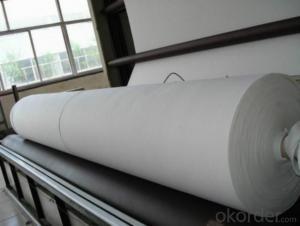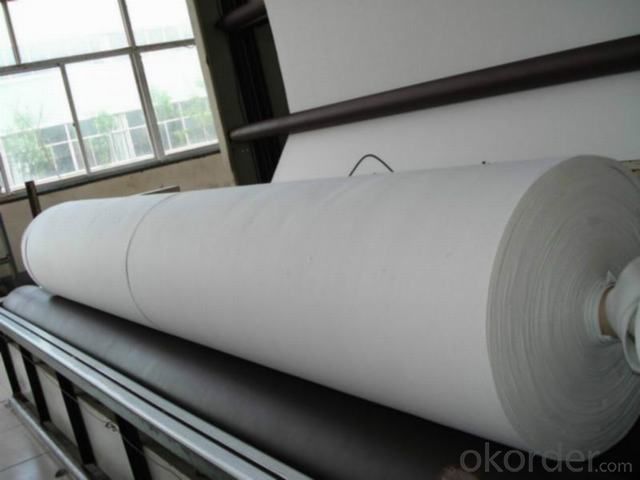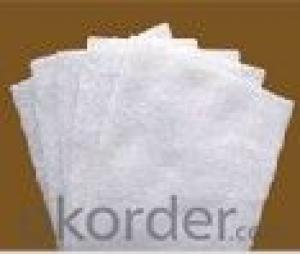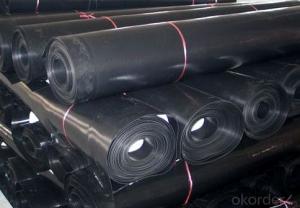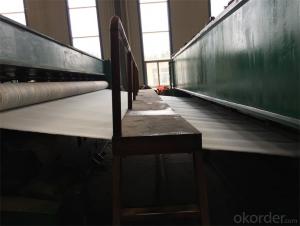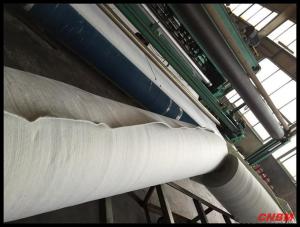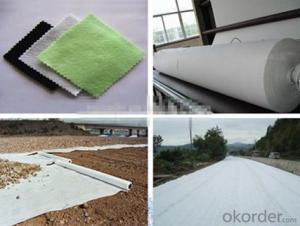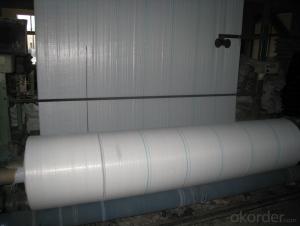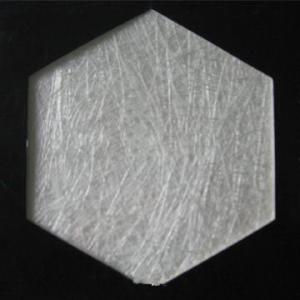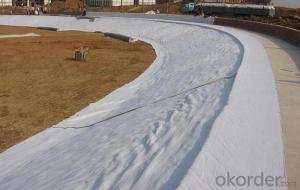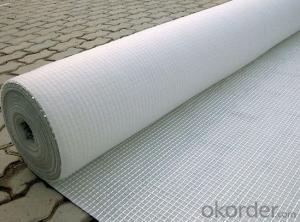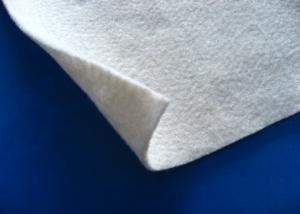Geotextile Filter Fabric Membrane - Excellent PP Woven Geotextile for Railway Construction
- Loading Port:
- Qingdao
- Payment Terms:
- TT OR LC
- Min Order Qty:
- 20000 m²
- Supply Capability:
- 1500000 m²/month
OKorder Service Pledge
OKorder Financial Service
You Might Also Like
Applications of PP Woven Geotextile for Railway Construction
1) Filtration
The filtration layer of the dykes, river canal, seacoast, concrete slope, retaining walls. At the same time of preventing the clay granule from passing, it allows the water and the gas pass through freely.
2) Separation
The isolation of the railway dregs and the roadbed, roadbed and the soft base, surface of the airdrome and parking lot and the groundsill, different dam materials. It isolates the soil and the gravel of two kinds different granule pathway from the groundsill or other buildings.
3 )Adding muscle
The highway, railway, soil-stone dam, breakwater, airport, backfill soil of retaining wall, slope protection, etc in which distributes the earth stress, prevents the side-displacement of the earth body and improves the earth body stability.
4 )Protection
It prevents the bank from being washed out, protects the bank and the bottom, prevents the water and soil from being washed away.
Technical Parameters of PP Woven Geotextile for River Construction
100 | 150 | 200 | 250 | 300 | 350 | 400 | 450 | 500 | 600 | 800 | NOTE | |
BASIS WEIGHT TOLERANCE (%) | -8 | -8 | -8 | -8 | -7 | -7 | -7 | -7 | -6 | -6 | -6 | |
THICKNESS ≥MM | 0.9 | 1.3 | 1.7 | 2.1 | 2.4 | 2.7 | 3.0 | 3.3 | 3.6 | 4.1 | 5.0 | |
TENSILE STRENGTH AT BREAKING ≥KN/m | 2.5 | 4.5 | 6.5 | 8.0 | 9.5 | 11.0 | 12.5 | 14.0 | 16.0 | 19.0 | 25.0 | MD&CD |
CBR PLUNGER STRENGTH ≥KN | 0.3 | 0.6 | 0.9 | 1.2 | 1.5 | 1.8 | 2.1 | 2.4 | 2.7 | 3.2 | 4.0 | |
TEARING STRENGTH ≥KN | 0.08 | 0.12 | 0.16 | 0.20 | 0.24 | 0.28 | 0.33 | 0.38 | 0.42 | 0.46 | 0.60 | |
BREADTH TOLERANCE (%) | -0.5 | |||||||||||
ELONGATION AT BREAKING (%) | 25-100 | MD&CD | ||||||||||
EOS O90mm | 0.07-0.2 | |||||||||||
VERTICAL PERMEABILITY (CM/S) | K×(101~~103) | K=1.0-9.9 | ||||||||||
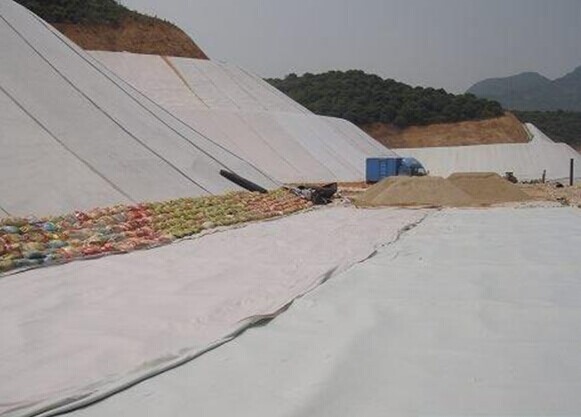

- Q: Can geotextiles be used in the construction of reservoirs?
- Yes, geotextiles can be used in the construction of reservoirs. Geotextiles are commonly used in civil engineering projects, including reservoir construction, to provide filtration, separation, and reinforcement. They can be used to prevent soil erosion, stabilize slopes, and enhance the overall performance and longevity of reservoir structures.
- Q: How do geotextiles help with reinforcement of embankments?
- Geotextiles help with the reinforcement of embankments by providing stabilization and strength to the soil, preventing erosion and promoting proper drainage. They act as a barrier by separating different layers of soil, preventing the intermixing of fine and coarse particles. This enhances the overall stability of the embankment and increases its load-bearing capacity. Additionally, geotextiles help to distribute the applied loads more evenly, reducing the potential for differential settlement and ensuring long-term stability of the embankment.
- Q: Can geotextiles be used in landfill construction?
- Yes, geotextiles can be used in landfill construction. They are commonly used as liners, covers, and drainage materials in landfills to prevent soil erosion, control water flow, and improve stability and performance of the landfill structure.
- Q: Can geotextiles be used in landscaping?
- Yes, geotextiles can be used in landscaping. Geotextiles are commonly used in landscaping projects as a way to control erosion, stabilize soil, and prevent weed growth. They are particularly useful in areas where there is heavy rainfall or sloping terrain, as they help to retain soil and prevent erosion. Additionally, geotextiles can be used to separate different layers of soil, provide drainage, and reinforce structures such as retaining walls.
- Q: What are the maintenance requirements for geotextile-reinforced retaining walls?
- The maintenance requirements for geotextile-reinforced retaining walls typically include regular inspections to check for any signs of damage, erosion, or settlement. Additionally, it is important to ensure that the drainage system is functioning properly to prevent water accumulation behind the wall. Any necessary repairs or adjustments should be promptly addressed to maintain the structural integrity of the retaining wall.
- Q: Are geotextiles resistant to extreme temperatures?
- Yes, geotextiles are designed to be resistant to extreme temperatures. They are made from materials that can withstand a wide range of temperatures, ensuring their durability and performance in various climatic conditions.
- Q: How are geotextiles used in shoreline protection?
- Geotextiles are used in shoreline protection as a barrier against erosion. They are placed along the shoreline to prevent the loss of sediment and stabilize the soil. The geotextiles act as a filter, allowing water to pass through while retaining the soil particles. This helps to reduce wave impact, control water flow, and protect the shoreline from erosion caused by natural forces.
- Q: How do geotextiles help with subgrade stabilization in road construction?
- Geotextiles help with subgrade stabilization in road construction by acting as a barrier between the subgrade and the overlying layers of the road. They distribute and reduce the load from the traffic, preventing the subgrade from becoming weak or uneven. Additionally, geotextiles can separate different soil layers, preventing them from mixing and improving the overall stability and strength of the road.
- Q: How do geotextiles help with reinforcement of geogrid reinforced soil slopes?
- Geotextiles help with the reinforcement of geogrid reinforced soil slopes by providing additional strength and stability to the system. They act as a separator between the soil and the geogrid, preventing soil particles from infiltrating the geogrid and reducing its effectiveness. The geotextiles also distribute the load evenly across the geogrid, improving its load-bearing capacity and reducing the potential for localized failures. Additionally, geotextiles can enhance the overall drainage and filtration properties of the slope, minimizing the risk of water accumulation and soil erosion.
- Q: What are the different geotextile installation techniques in erosion control?
- Some of the different geotextile installation techniques in erosion control include slope stabilization, sediment control, and shoreline protection. These techniques involve placing geotextile materials in strategic locations to prevent soil erosion, retain sediments, and protect vulnerable areas from wave action.
Send your message to us
Geotextile Filter Fabric Membrane - Excellent PP Woven Geotextile for Railway Construction
- Loading Port:
- Qingdao
- Payment Terms:
- TT OR LC
- Min Order Qty:
- 20000 m²
- Supply Capability:
- 1500000 m²/month
OKorder Service Pledge
OKorder Financial Service
Similar products
Hot products
Hot Searches
Related keywords
